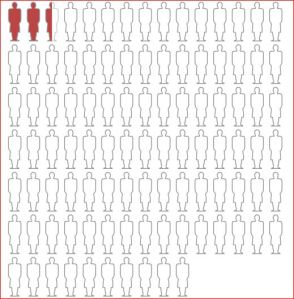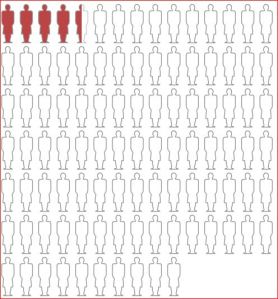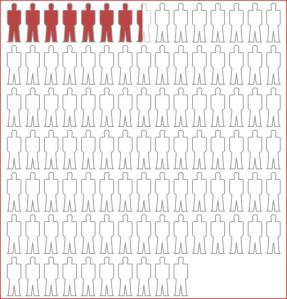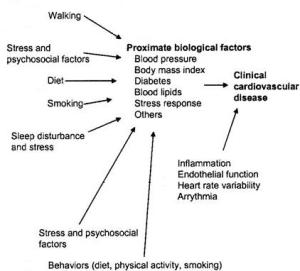Safety hazards in labs are real & often due to health & safety officials and regulations. http://bit.ly/XqzalQ
”On Exactitude in Science” by Jorges Luis Borges may be instructive….
“……the Cartographers Guilds struck a Map of the Empire whose size was that of the Empire, and which coincided point for point with it……The following Generations, who were not so fond of the Study of Cartography as their Forebears had been, saw that that vast Map was Useless, and not without some Pitilessness was it, that they delivered it up to the Inclemencies of Sun and Winters. In the Deserts of the West, still today, there are Tattered Ruins of that Map, inhabited by Animals and Beggars;….”
—Suarez Miranda, Viajes de varones prudentes, Libro IV, Cap. XLV, Lerida, 1658
Hat tip to 1 boring old man
We are constantly bombarded with alarming announcements about heart attack risks. Many hundreds of billions of dollars are spent annually in multiple ways trying to avoid dying from a heart attack.
It is a bit shocking to actually see what the 10 year heart attack mortality risk looks like. I don’t know what your reaction will be but my was, “Huh, wow, that’s not such a big deal. Maybe I should just relax, live as healthily as possible and ignore all the medical screaming and shouting.
I have used the data table found on page 128 in the very readable, and useful book Know Your Chances by Woloshin, Schwartz and Welch.
About the illustration-
There are 100 women icons. The darker icons represent the number of 65 yr old nonsmoking women who will die of heart attack before they become 75 yrs old. (2.5 women in this group will die of heart attack in the next 10 yrs.)
Now let’s do the same sort of chart for a 100 women who smoke. In this case, the data claims that 4.5 of these 65 yr old smokers will die of heart attack before the age of 75.
By the way, if you want to create a graphic of this nature, you can find the tool to do so at http://understandinguncertainty.org/visualfraction
We are constantly bombarded with alarming announcements about heart attack risks. Many hundreds of billions of dollars are spent annually in multiple ways trying to avoid dying from a heart attack.
It is a bit shocking to actually see what the 10 year heart attack mortality risk looks like. I don’t know what your reaction will be but my was, “Huh, wow, that’s not such a big deal. Maybe I should just relax, live as healthily as possible and ignore all the medical screaming and shouting.
I have used the data table found on page 128 in the very readable, and useful book Know Your Chances by Woloshin, Schwartz and Welch.
About the illustration-
There are 100 men icons. The darker icons represent the number of 65 yr old nonsmoking men who will die of heart attack before they become 75 yrs old. (5.2 of this group will die of heart attack in the next 10 yrs.)
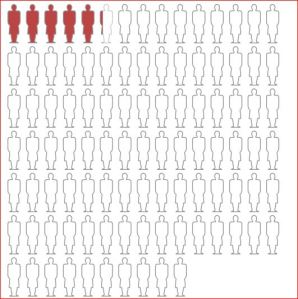
Now let’s do the same sort of chart for a 100 men who smoke. In this case, the data claims that 7.4 of these 65 yr old smokers will die of heart attack before the age of 75.
Here is a link to a pdf which has downloadable risk charts: Health Risks by Age, Sex and Smoking Status
The bag of tricks for promoting various drugs, and medical devices testifies to a ingeniousness on the part of marketing departments. This link provides a template for luring journalists by baiting the hook with prominent academic researchers.
How academic physicians are being used as live bait for journalists by Larry Husten of CardioBrief.Org
” Hi Larry:
More than [VERY BIG NUMBER] Americans suffer from [COMMON DISEASE] and it is one of the few cardiovascular diseases on the rise. A new study, published online today by [FAMOUS JOURNAL], reveals there are gaps in the quality of [COMMON DISEASE] care provided to thousands of patients by cardiologists who don’t always follow guidelines for patient treatment.
As featured in [FAMOUS NEWSPAPER], the [BIG STUDY] is the largest [STUDY OF ITS TYPE] …
Would you be interested in learning more about the existing gaps in [COMMON DISEASE] patient care… Please let me know what you think and I could help arrange the following interviews:….”
more via
How academic physicians are being used as live bait for journalists
There used to be a time when people went to health care practitioners to help with a perceived illness but increasingly the siren songs of “better than well” are changing the boundaries between healing and enhancing. Hence, I ask the rhetorical question: And at what point does a physician become a drug pusher?
Here is a link to an article in Psychiatric Times that wrestles with this issue:
Should Psychiatrists Prescribe Neuroenhancers for Mentally Healthy Patients?
by Cynthia M. A. Geppert, MD, PhD, MPH and Peter J. Taylor, DO, MA
“In 2009, the Ethics, Law and Humanities Committee of the American Academy of Neurology (AAN) issued guidance regarding responding to requests from adult patients for neuroenhancers.1 The AAN report defines this term as “prescribing medications to normal adults for the purpose of augmenting their normal cognitive or affective function.” The author, Cynthia Geppert, has previously summarized the content of the AAN paper in aPsychiatric Times podcast available at http://www. psychiatrictimes.com/podcasts.
Recent articles in both The New Yorker2 and Nature3 confirm the widespread use of cognitive enhancers, especially among students and academics. Prevalence is a pragmatic but not necessarily an ethical argument. The most controversial aspect of the guidance is its underlying assumption that a valid goal of medicine is to improve the executive function of individuals who have no “diagnosable mental health or medical condition.”
There has been considerable commentary on the topic of the report in the neurology journals and bio-ethics blogs—most of it favorable—although there have been some essays of caution.4-7 There has been surprising little discussion in the psychiatric community, where a broad and morally serious dialogue on the subject of cosmetic psychopharmacology has not occurred since Peter Kramer’s prescient Listening to Prozac.8 The one notable exception is a Medscape news report on a presentation Derryck Smith, MD, made at the 60th Annual Conference of the Canadian Psychiatric Asso-ciation in September 2010.5
Since patients are already taking these medications, and we as psychiatrists are familiar with the utility of the drugs for clinical indications, Smith argues that it would be in the best interest of patients if psychiatrists prescribed neuroenhancers in a medical setting. The article quotes Smith as saying, “I am absolutely fascinated that the neurologists are in this game before psychiatrists. Psychiatry should be at the forefront of this because these are all medications that we use on a regular basis.” He refers to the guidance of the AAN as supporting the safety, ethics, and reasonableness of prescribing these medications if they will benefit patients. He concludes, “So psychiatrists are at liberty to use these medications as they see fit with fully informed patients.”
In this article, we present a counterpoint to Dr Smith’s position, and indeed to the application of the AAN guidance to psychiatry. We argue on the basis of core concepts in psychiatric ethics that psychiatrists should not at this time prescribe neuroenhancing medications for patients who lack clinical indications for these drugs…”
There is much more at the link, though you’ll have to register for a free subscription:
Should Psychiatrists Prescribe Neuroenhancers for Mentally Healthy Patients?
I am quite sure that the vast majority most of you recognize what the major cardiovascular risk factors (though: there are over 100).
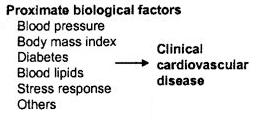 Congratulations! But now we begin to pull the rope, what are the causes of these “risk factors” (not causes)?
Congratulations! But now we begin to pull the rope, what are the causes of these “risk factors” (not causes)?
Well, the lifestyle. So far we agree. But what are the determinants that we make certain habits and not others?
Recoiling our steps we find the source of all problems: the causes of the causes of the causes of cardiovascular disease do not fall in hypercholesterolemia and hypertension.
If Ramiro, who lives in a suburb with little playground, a couple of minutes walk from a factory spewing nitrogen and benzene vapor 24 hours a day, which has limited financial resources and therefore less access to food ” Heart-which has an expectation of working life very unsatisfactory, and so on. etc. If Ramirez does not have a healthy lifestyle is because their lives, their natural environment, social, family and staff are not as favorable as he wanted. Does it make sense then that thousands of Ramiros take statins for primary preventionor dedicate these resources to try to improve the lives of these people?
Now, I propose another year. Imagine that hipercolesteromemia treat with statins, and that everything else remains the same. According to data from meta-analysis in primary prevention, statins to prevent achieved after five years of treatment the death of a person as Ramiro we treat 60 to 300 people . Imagine that our friend is one of them, and getting rid of dying from heart attack, but still having a miserable life. Probably end up dying of something else, and quite possibly something related to the causes of their causes (maybe a tumor? A knife in a fight?). Therefore, we can not outwit death, alone, in any case, prolonging lives and change the cause of death …
He explains Iona Heath, British family doctor and president of the Royal College of General Practitioner, in the book “Innovation around the clinical prevention” (partly reflected in this article ):
By Providing Treatment Designed to Prevent particular diseases.Selecting we May Be Another cause of death for unkowningly, and Certainly Without the patient’s informed consent.
Therefore, before rushing into a titanic effort to prevent disease pastillazos effort should be made in each person, try to identify the causes of the causes of their causes, and not to create false hopes that the medicine gets reduced to zero risk of disease, or that prevention is able to outwit death itself .
Idea, reviews and charts from Rafa Cofiño .
[ Diez-Roux, AV. Residential Environments and Cardiovascular Risk. J Urban Health 2003, 80:569-89 .]
Interesting study on how metaphor both helps and hinders thinking.
PLoS ONE: Metaphors We Think With: The Role of Metaphor in Reasoning.
Here is a link to an excerpt from the book White Coat, Black Hat about how diseases are sometimes created to sell new drugs or rehabilitate old drugs.
Unfortunately, this occurs much more frequently than we might think.
here is an excerpt of the excerpt:
…People get diseases; scientists develop drugs to treat those diseases; and marketers sell the drugs by showing that the drugs work better than their competitors. Sometimes, however, this pattern works in reverse. Drug company scientists develop a drug with a range of physiological effects, none of which are terribly helpful, so the marketers must identify and promote a disease for the drug to treat. This might mean co-opting a rare disease whose borders can be expanded to encompass more patients, or redefining an unpleasant aspect of ordinary life as a medical pathology. Once a disease has achieved a critical degree of cultural legitimacy, there is no need to convince anyone that a drug is necessary. It will come to him as his own idea.”…
read the whole excerpt via Create a disease to market a drug
Better yet read the whole book White Coat, Black Hat

hat tip to Kevin M.D. blog
One of the strongest criticism used against an unconventional medical treatment is that it is based only on “anecdotal evidence.”
Well, according to the current New England Journal of Medicine more than half of current recommendations are supported only by “expert opinion” and “anecdotal evidence.”
The following quote is taken from Gary Switzer’s HealthNewsReview blog
Reuters Health reports on the publications:
"Even when following medical guidelines to the letter, doctors often use treatments that have little or no scientific support, U.S. researchers said Monday.
They found only one in seven treatment recommendations from the Infectious Diseases Society of America (IDSA) — a society representing healthcare providers and researchers across the country — were based on high-quality data from clinical trials.
By contrast, more than half the recommendations relied solely on expert opinion or anecdotal evidence."
more via New questions about medicine’s “best practice” guidelines.
Be sure to check out these links to the NEJOM: article here and the editorial here
